Continuo con la cronologia secondo il Weekly Epidemiological Record dell'OMS. Nel post precedente in cui raccontavo il primo anno della pandemia che era cominciata nel 1968, l'ultimo bollettino era del 9 maggio 1969. Durante parte della primavera, l'estate e l'inizio dell'autunno in Europa, negli USA ed in Canada non si registravano ulteriori epidemie d'influenza.
All'inizio di ottobre il virus begins to take hold in Europe again, starting with Spain. At the end of October there is a high incidence of flu in all age groups. In some places (schools, offices, military units) 10% of people get sick, almost simultaneously. In Barcelona the level of attack is 20% and 30% in the suburbs. The virus responsible is the H3N2 (Hong Kong).
The virus does carry da un viaggiatore dalla Spagna in Danimarca. Anche nel Regno Unito, a Cambridge sembra esserci un focolaio.
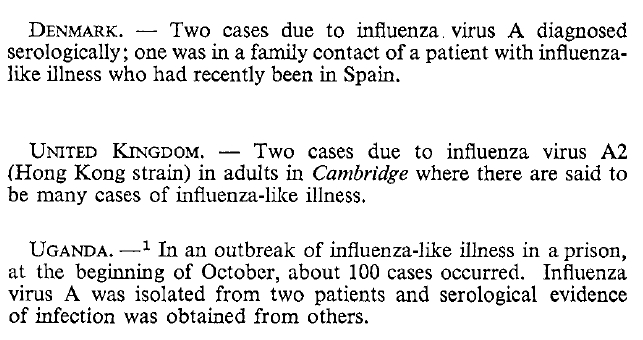
In Spagna l'epidemia si allarga a Barcelona ed in tutta la sua provincia. Più del 30% della popolazione si ammala e tutte le fasce di età sono colpite. Nella maggior parte dei casi la malattia è benigna ma in alcuni si sviluppa una broncopolmonite, soprattutto in persone ricoverate con malattie regresse.
Anche in alcune città della Francia il virus comincia a causare estese epidemie.
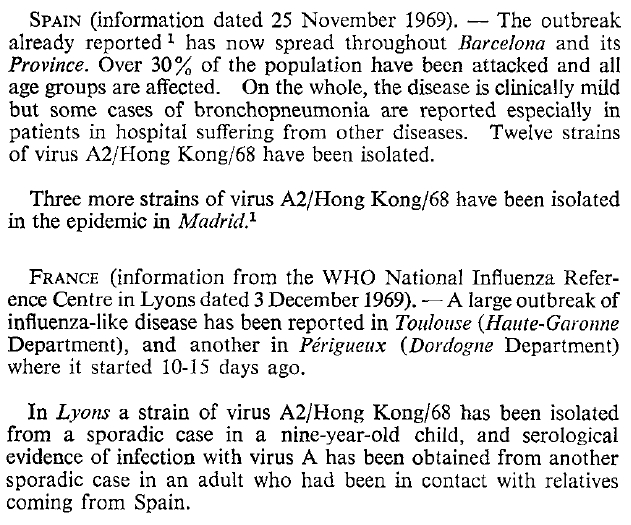
In France, the epidemic spreads to other areas.
Even in Italy there is an epidemic covering all the country. The disease is described as benign.
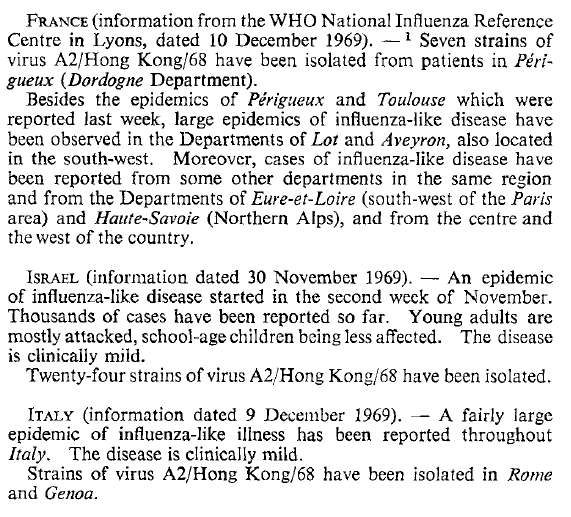
In Austria, the virus looks in Carinthia, which borders Italy and Yugoslavia. The epidemic spread rapidly throughout la provincia. Si ammalano prevalentemente gli adulti. La malattia è benigna o moderata.
Anche in Belgio ci sono alcuni focolai.
In Danimarca il numero dei casi aumenta in tutto il paese. A Copenhagen si va da 669 casi di sindrome influenzale segnalati nell'ultima settimana di novembre a 1386 nella settimana successiva.
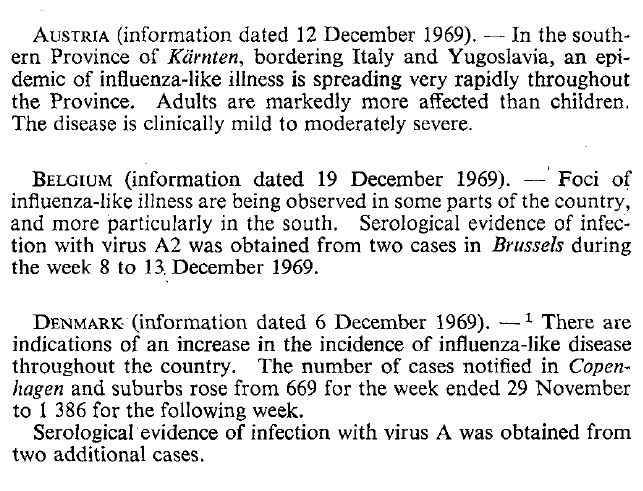
In Spagna l'epidemia sembra in discesa. A Novembre la mortalità generale è stata del 40% più alta rispetto al novembre 1968 e le fascie d'età maggiormente colpite sono le persone di più di 50 years and those between 21 and 30 years.
In France, the epidemic is expanding rapidly. On 110 blood tests show 35% infection with the H3N2 virus (Hong Kong) and 3% of the parainfluenza virus type 1.
Austria: A Vienna and Vorarlberg as the epidemic grows in the province of Carinthia is ending.
In Bulgaria there is an epidemic of influenza caused by influenza type B. Samples collected from the virus seems that there are only few cases of influenza A.
In Finland the increased cases of flu. The disease is benign.
In Greece there are more and more cases. Athens 20% of the population gets sick and all ages are involved. The disease is generally benign with an acute phase of 3-4 days and often patients complain of a sore throat unusual insistence and persistence.
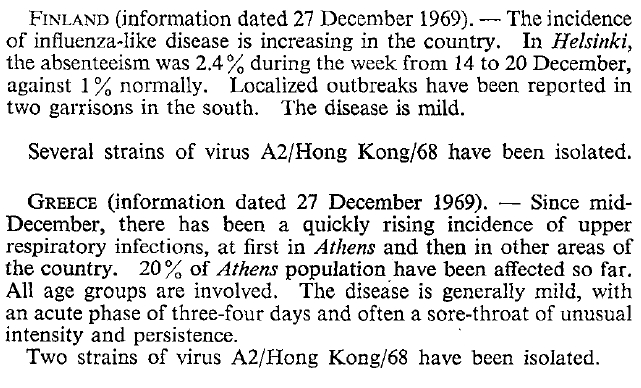
Holland: There are at present only a few localized outbreaks. So far the level is about half the previous year.
Norway: here the virus begins to cause epidemics.
In Sweden the increase in cases decided so. In the week ending December 19 with 16,000 cases are reported against 754 in the month of November.
In England and Wales the number of deaths from influenza and pneumonia has doubled in the week that ends on December 26 from 297 to 702 (number provisional). In the corresponding week of last year there were 30 recorded deaths. The number of hospitalizations increased from 1480 to 2030 (1270 in the corresponding week last year).
in Brussels on 15% of popolazione si ammala e tutte le fasce di età sono colpite.

In Finlandia l'epidemia sta diminuendo.
In Francia dove l'epidemia è stata molto estesa i casi diminuiscono ma l'epidemia non è ancora finita.
Anche in Italia il virus continua a circolare ma l'epidemia è ora meno intensa.
In Portogallo c'è invece un forte increase.
In Spain the epidemic is over. In some provinces, became ill on 15 - 30% of the population.
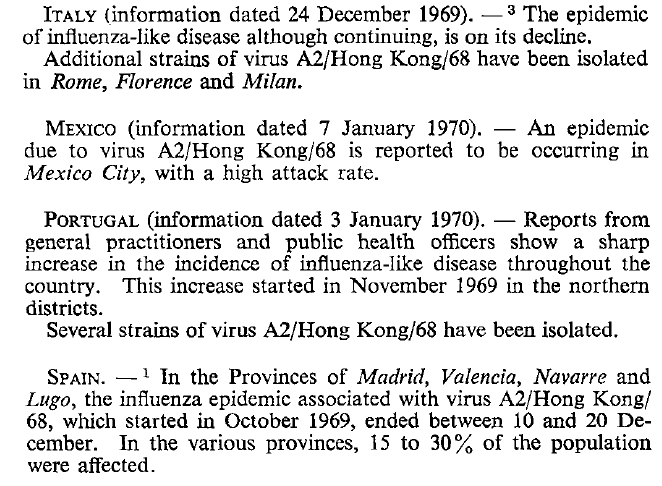
In Sweden, the epidemic has spread throughout the country

In England and Wales, deaths from influenza and pneumonia are increasing sharply. From 702 in the week ending with December 26, 1969 to 3170 for the week che finisce con il 2 febbraio 1970. Nella settimana corrispondente del 1969 erano 21.
In Austria il virus si diffonde in alcune province mentre l'epidemia è finita in altre.
In Bulgaria è il virus influenzale B che ha preso piede, mentre il virus A è molto meno presente.
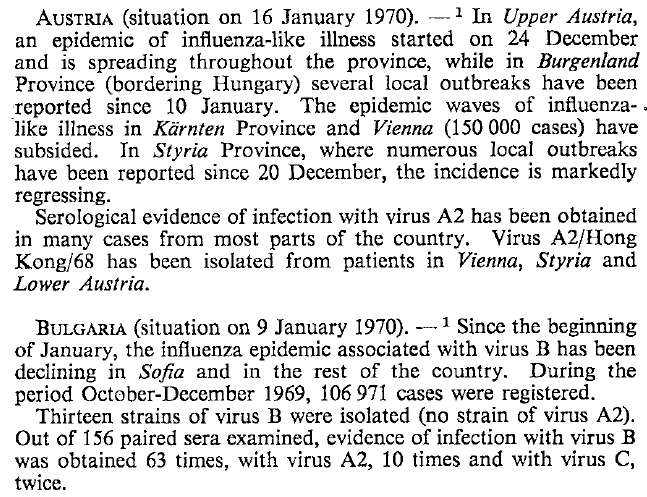
In Cecoslovacchia la malattia si presenta usually benign, but cases of complications and death are more frequent in the previous year.
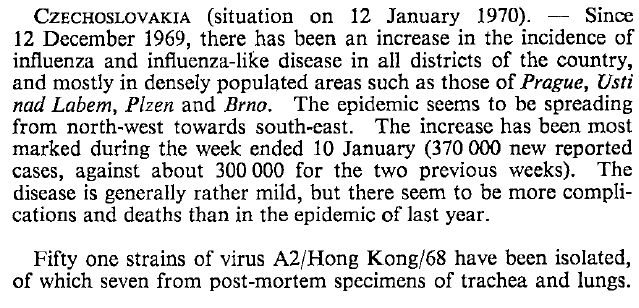
Denmark: The number of patients with positive serological evidence for influenza A is still very high, but clinical cases are decreasing.
Germany: The number of cases of flu is still high in some areas, in others, the epidemic is declining. In some cases the clinical picture shows a slow recovery.
In Inghilterra e nel Galles l'epidemia sta decrescendo.
In Scozia ci sono ancora epidemie estese con alti numeri di richiesta di indennità per malattia. Da 33.873 nella settimana prima di natale a 49.176 nella prima settimana di gennaio. I casi di morte per influenza nelle rispettive settimane aumenta da 14 a 113.
Negli USA invece l'epidemia non supera la soglia che normalmente è attesa per questo periodo dell'anno.
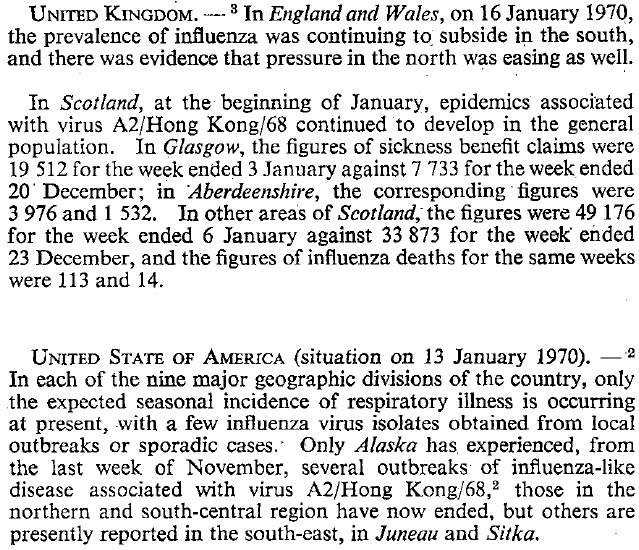
On 24 January 1969, the epidemic is declining or even ended up in Austria, Sweden, Switzerland and the United Kingdom.
In Canada, except in some areas, there have been no major epidemics.
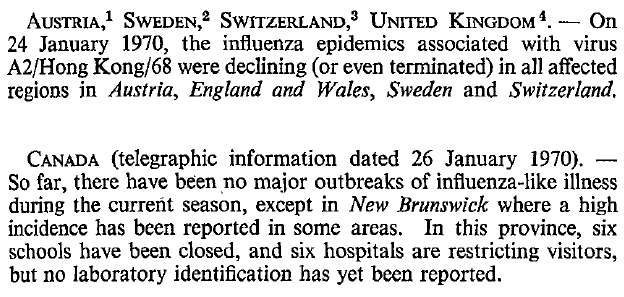
In Czechoslovakia, the incidence of flu is decreasing. During the peak weeks of the overall impact was more di 4.700 casi per 100.000 contro un po più di 1.000 per 100.000 nel primo anno della pandemia. Anche se la malattia era generalmente benigna, il numero di casi che presentavano un quadro clinico protratto e quelli con complicanze e morti (soprattutto polmoniti o broncopolmoniti) sono aumentati durante gli ultimi quindici giorni.
Danimarca: l'epidemia continua a diminuire. La malattia è generalmente benigna, comunque c'è stato un aumento di casi con complicanze (soprattutto polmoniti) ed anche la tendenza per un decorso prolungato e con esito fatale è stato riportato, soprattutto nella fascia di età più avanti con gli anni. Questa tendenza è stata riportata un pò da tutti i paesi durante questa ondata della pandemic.
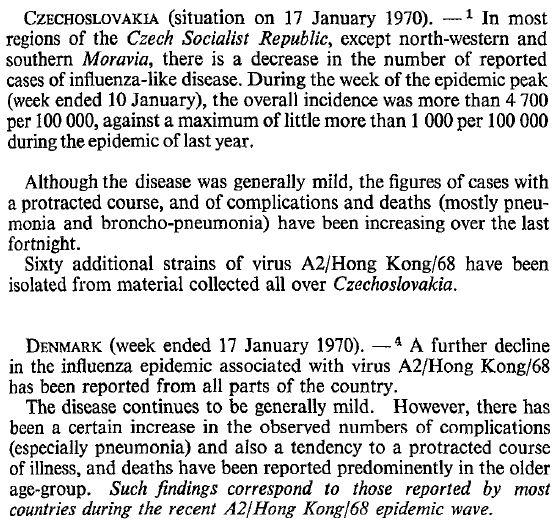
In Germany, the epidemic is declining. Hungary continues slowly on his way to Holland while there is a high incidence of flu.
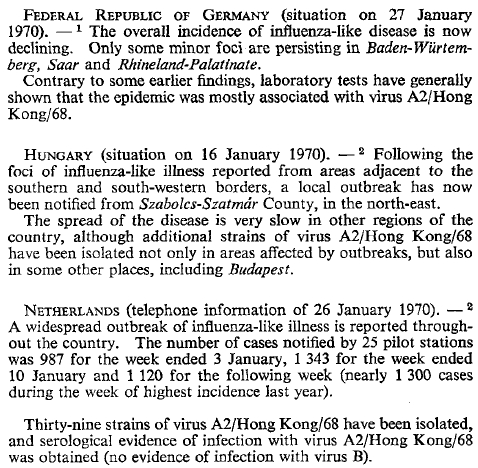
In Canada there is an epidemic in Newfoundland, with many cases of pneumonia.
In Czechoslovakia in all regions are now reported cases of flu.
In Hungary the increase in cases of flu in the central and western areas while in the north-east there are only sporadic cases.
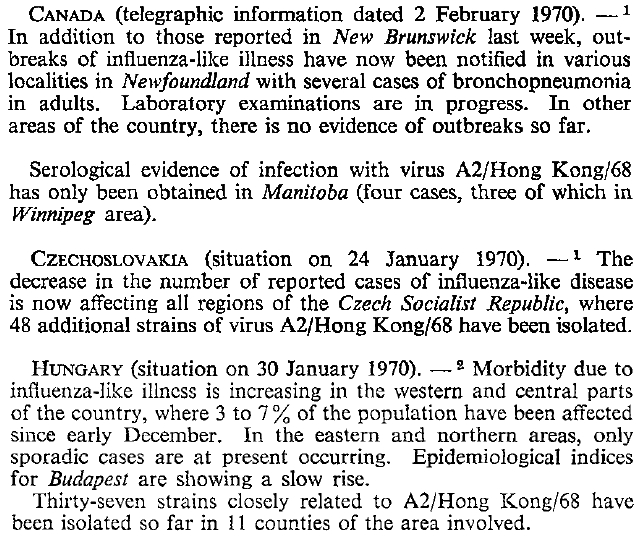
In Glasgow in Scotland claims for compensation for illness, and deaths from respiratory diseases and influence are declining.
In the U.S. cases of death polmonite e influenza nelle 122 città campioni sono stati più alti del livello atteso per la stagione ma ora il numero di questi casi sta diminuendo. In altre zone invece c'è un leggero aumento di questo trend. Questo significa probabilmente che ci sono alcuni focolai locali in luoghi che non erano stati colpiti dalla vasta epidemia dell'anno precedente.
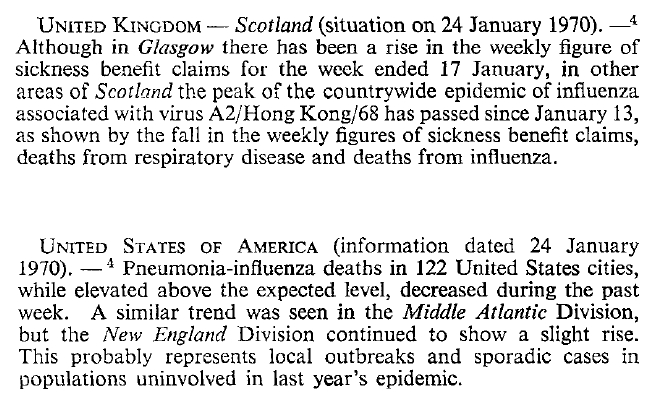
Germania: il Centro Nazionale Influenza ha svolto una ricerca serologica per verificare la diffusione del virus nella popolazione. Starting from week 51 every week were examined 100 samples of blood were sent for a search on blood groups. Between week 51 of 1969 and the third week of 1970 there was a 31% increase in the proportion of samples with antibody levels to influenza A virus in 1 / 64 or more and an equivalent increase was registered with an antibody level of 1 / 32 or more. See table. The center informs that in the period between 23 December 1969 and January 7, 1970 at least 70% of patients had flu influenza virus A. The center points out that the disease is generally benign but that there were severe cases with bronchitis and pneumonia and even fatal.
in Holland in some parts of the country, the epidemic is declining, while in others the incidence is still high. The 15 largest municipalities in the month of December were 19 reported cases of death on the 30th of December last year, although in 1969 the number of cases of flu was higher. In the same 15 towns, 185 deaths were reported 1 to 23 January 1970, during the peak of the wave.
In the U.S. we see a new rise in deaths from pneumonia and flu, although there has been only sporadic outbreaks.
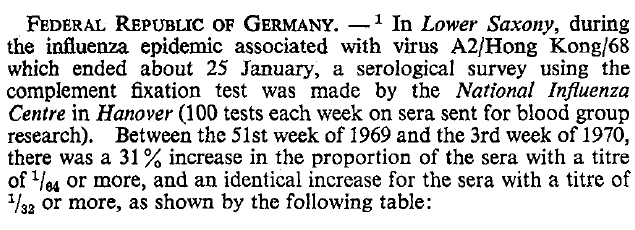

In Ungheria, dopo un inizio lento, l'epidemia comincia a correre. Il numero d'indennità per malattia è aumentato di 4-5 volte rispetto al livello del settembre 1969. Sono stati isolati anche alcuni ceppi del virus dell'influenza B, ma l'epidemia è principalmente causata dall'influenza A.
In Olanda l'epidemia sta diminuendo.
Nel Regno Unito la circolazione del virus è sensibilmente diminuito.
... ed in Bulgaria (dove, come già detto, l'epidemia era stata causata dal influenza B), ed in Canada
Nel Regno Unito l'epidemia dell'influenza A viene sostituita da un focolaio dovuto all'influenza B.
Negli USA, dove il picco sembra finito, si continua a registrare una più alta incidenza di morti per polmonite e influenza of that expected for this time of year.
In Canada there are now only a few outbreaks.
In Czechoslovakia, the incidence of flu remains high in all regions. In the last week of February, 2,000 cases were reported with 27 deaths and complications. In the same week the number of reported cases was 53,237 (compared to 269,759 during the first week of January when there was the peak of the wave).
In the U.S., influenza and pneumonia mortality decreases significantly, with only a region that continues to be above the level expected for this week of the year.
Weekly Epidemiological Report, March 13, 1970
In Germany, for the excess mortality was higher for influenza epidemic of 1957-58, of 1960 and 1968 who had a similar number of cases of influenza syndrome reported. In December and January, the excess mortality compared to the year 5680 was no epidemic - more than 33% of the excess mortality was recorded in the first year of the pandemic in the months of January and February 1968.
In Hungary, the epidemic is declining. More than two million influenza-like illness were reported (approximately 20% of the population).
In the Netherlands the number of cases of flu has reached the level expected for the season. The number of deaths reported from 15 districts with more than 100,000 inhabitants aveva raggiunto 308 dall'inizio di dicembre 1969 al 22 febbraio 1970, contro 220 dal dicembre 1968 al febbraio 1969, anche se il numero dei casi era simile nelle due epidemie.
In Polonia, nonostante che ci sia stata un'estesa epidemia nel primo anno della pandemia con più di 3.5 milioni di casi di sindrome influenzale registrati, anche nel secondo anno si è verificata una grande epidemia con 3.744.135 casi. La malattia era generalmente benigna, ma complicazioni ed alcuni casi fatali sono stati segnalati.
In Inghilterra e nel Galles il numero dei morti attribuiti direttamente influenza caused by influenza and pneumonia decreased to 11 from 36 the previous week (and 100 in the corresponding week last year).
Weekly Epidemiological Report, March 26, 1970
In the Netherlands the rate of cases mortality seems to be higher in the first year of the pandemic.
In Czechoslovakia the epidemic is almost over.
Weekly Epidemiological Report, April 10, 1970
The summary of the second year of the last pandemic located in the Weekly Epidemiological Record of September 25, 1970 . I have also prepared this a pdf file . At Spreadsheet I added a second table. It 's very clear that the winter of 1969/70 the impact of the pandemic was greater. In many European countries, the incidence was high and there were more cases of complications and death. I would also stress that the number of deaths reported during the outbreak of the WER is only that of deaths directly attributed to influenza, but it is very important to know that these numbers significantly underestimate the true number of deaths due to this virus. I will explain it better in my next post.
In summary states that the WER from October 1969 to March 1970 in almost all European countries there were large epidemics caused by influenza A/H3N2 (Hong Kong). In general this was the first massive attack of this virus in the previous winter had caused a number of low / moderate cases. The Netherlands and Poland who had lived very strong epidemic had shown a high incidence for the second consecutive year. In the U.S., the incidence was moderate, after the severe epidemic of the previous year.
In this second year the influenza virus A/H3N2 (Hong Kong) was generally similar to the original strain. However, a slightly different antigenic variant, called A2/England878/69 had appeared in the United Kingdom (34 strains tested on 850), France (2 strains out of 25 surveyed) and Portugal (2 strains out of 33 examined). This new variant was isolated just before the report in New Zealand, but did not seem to have been identified in other countries.
The clinical picture was generally benign or moderate. Some countries reported that the disease had evolved over a long period of prolonged weakness after the acute phase of healing. In many countries there were more complications in the form of pneumonia, the usual. Denmark reported an increased incidence of pneumonia when the epidemic was in decline. The influence caused a relatively high number of deaths, often due to pneumonia. In Holland, for example, mortality was significantly higher than the previous year, although the number of cases was slightly lower. Especially the elderly - and in smaller numbers - in young children developed pneumonia. However, even among young adults have reported cases of pneumonia and even in this population group were fatal. The results of autopsies done in Czecoslovacchia showed that pulmonary complications were often directly linked to the virus, rather than due to secondary bacterial infections.
Some of the lessons that teaches us the last pandemic is
In summary states that the WER from October 1969 to March 1970 in almost all European countries there were large epidemics caused by influenza A/H3N2 (Hong Kong). In general this was the first massive attack of this virus in the previous winter had caused a number of low / moderate cases. The Netherlands and Poland who had lived very strong epidemic had shown a high incidence for the second consecutive year. In the U.S., the incidence was moderate, after the severe epidemic of the previous year.
In this second year the influenza virus A/H3N2 (Hong Kong) was generally similar to the original strain. However, a slightly different antigenic variant, called A2/England878/69 had appeared in the United Kingdom (34 strains tested on 850), France (2 strains out of 25 surveyed) and Portugal (2 strains out of 33 examined). This new variant was isolated just before the report in New Zealand, but did not seem to have been identified in other countries.
The clinical picture was generally benign or moderate. Some countries reported that the disease had evolved over a long period of prolonged weakness after the acute phase of healing. In many countries there were more complications in the form of pneumonia, the usual. Denmark reported an increased incidence of pneumonia when the epidemic was in decline. The influence caused a relatively high number of deaths, often due to pneumonia. In Holland, for example, mortality was significantly higher than the previous year, although the number of cases was slightly lower. Especially the elderly - and in smaller numbers - in young children developed pneumonia. However, even among young adults have reported cases of pneumonia and even in this population group were fatal. The results of autopsies done in Czecoslovacchia showed that pulmonary complications were often directly linked to the virus, rather than due to secondary bacterial infections.
Some of the lessons that teaches us the last pandemic is
- that it is still important to get vaccinated against the H1N1 virus (2009) because there will probably be another epidemic (or early winter of 2010 or 2010/11) and this could affect many more people and even kill the first wave. Why risk it? Although today no one can know with certainty whether the next wave of the virus will change antigenically or not, there is the possibility that the vaccine provides us with sufficient protection. At least the last pandemic, the virus circulating in the second year was antigenically similar to strains of the first year.
- In Europe, the pandemic of 1968 began during the winter and continued for several months, in many countries until the spring. The current pandemic has surprised a few months before winter, so there is the possibility of another outbreak (possibly together with the seasonal flu virus?) During the months when the flu usually comes to visit us .
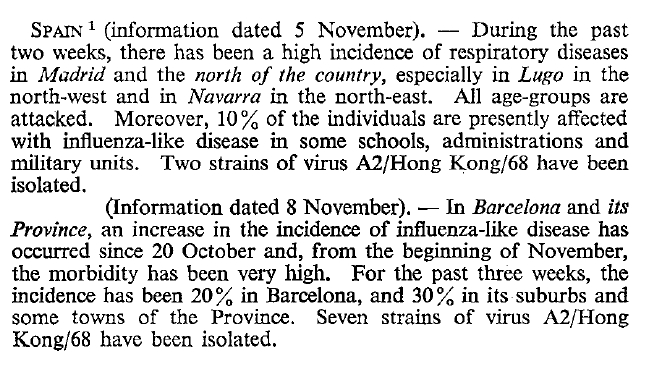
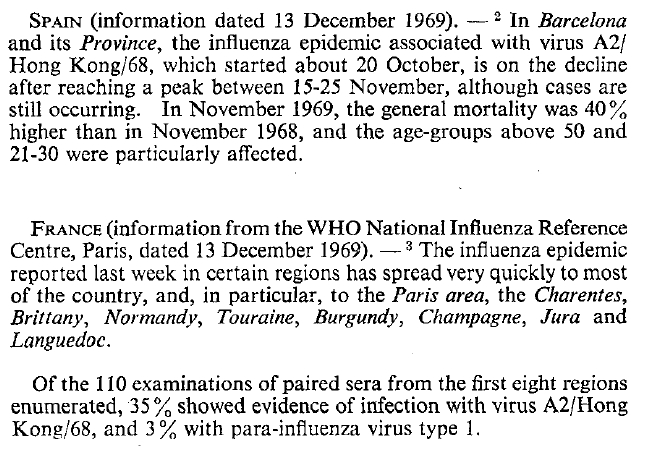
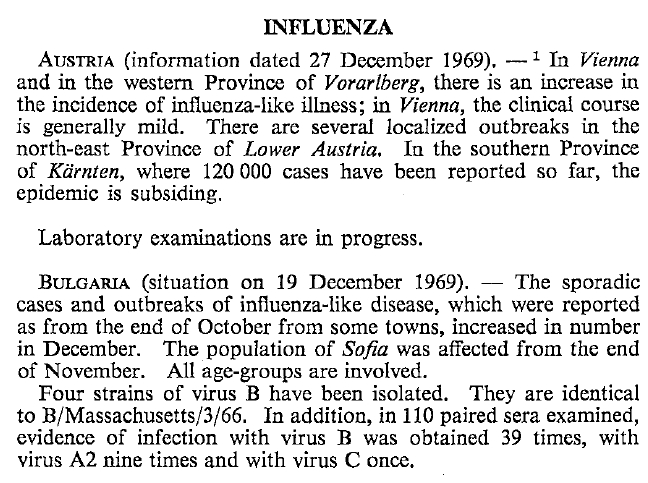
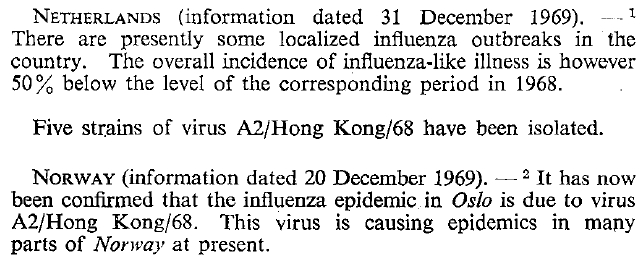
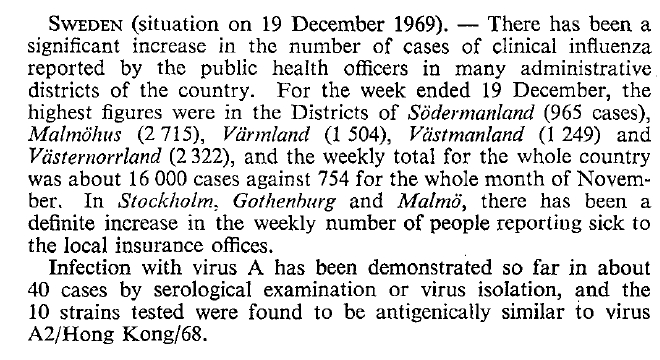
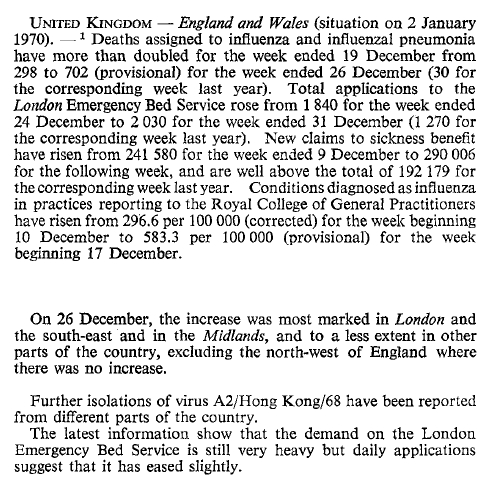
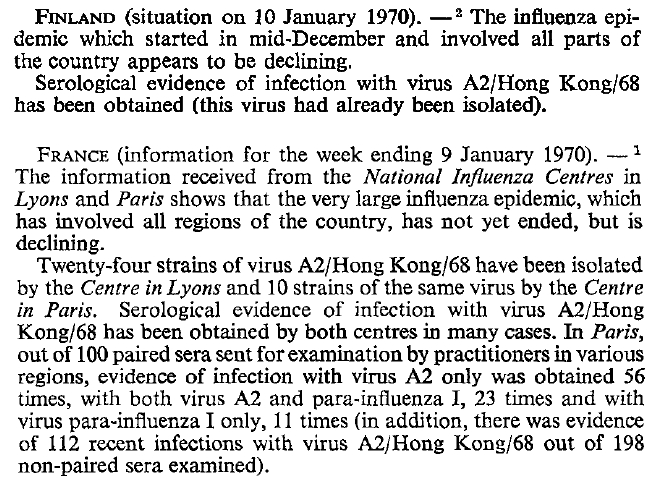
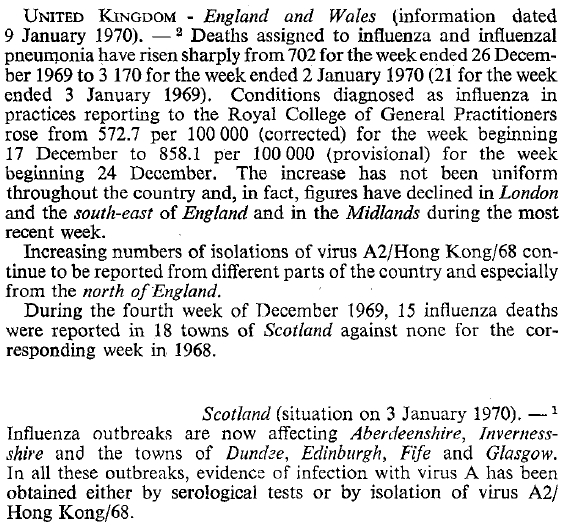
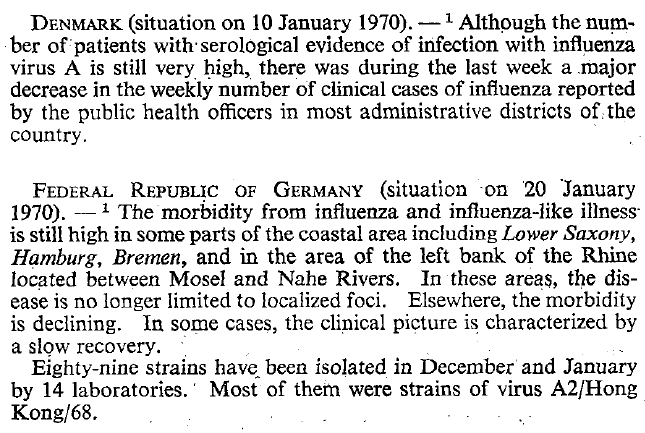
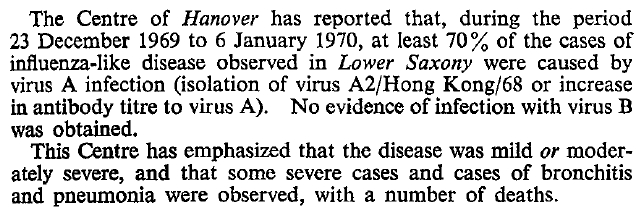

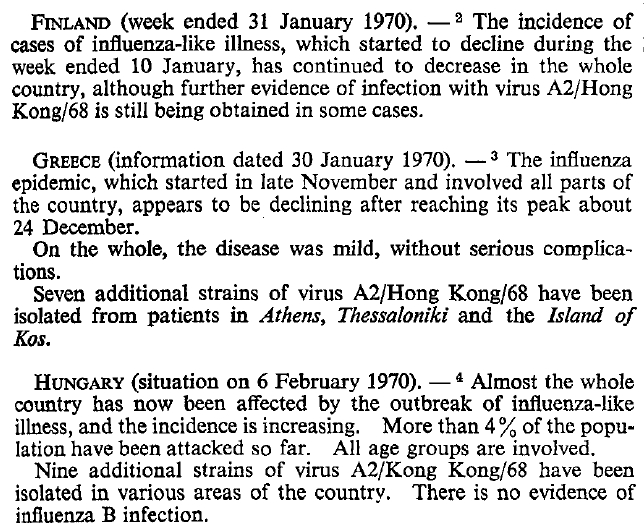
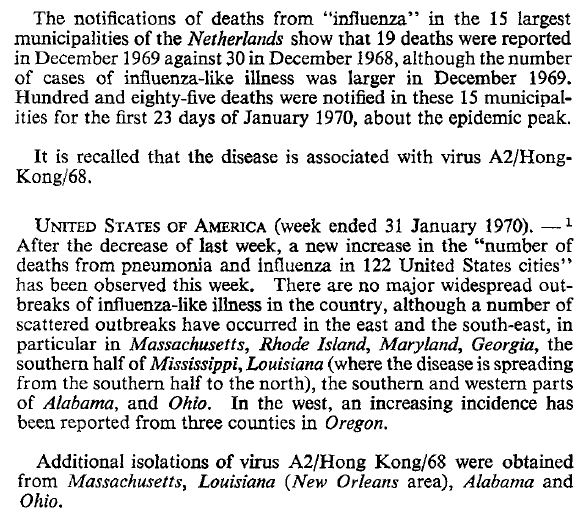
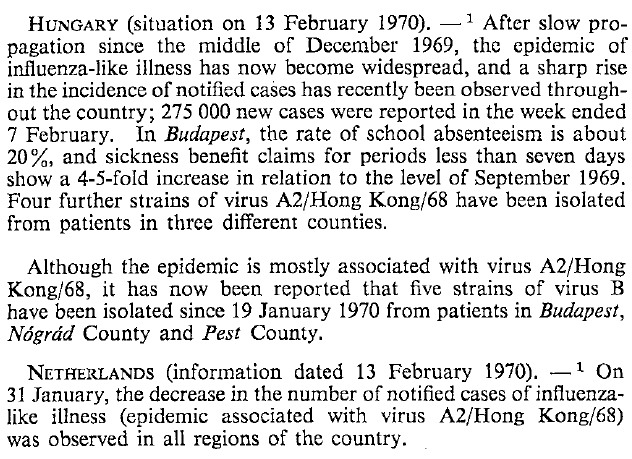
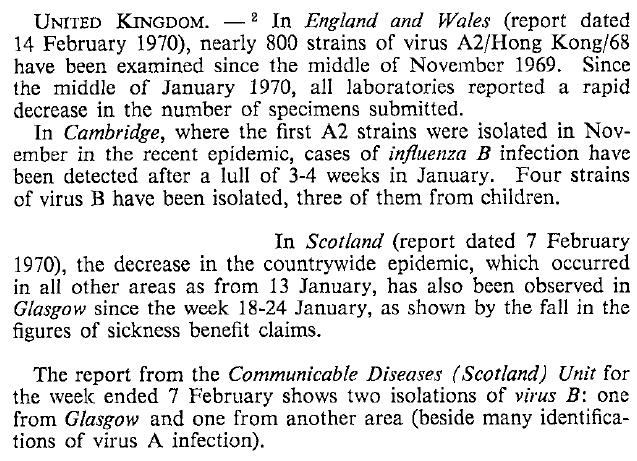
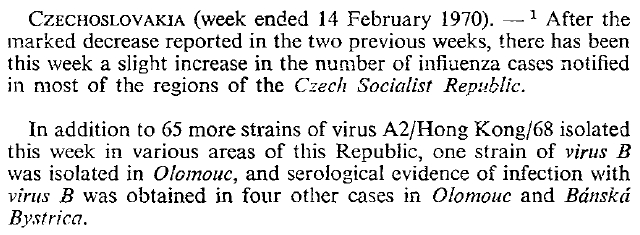
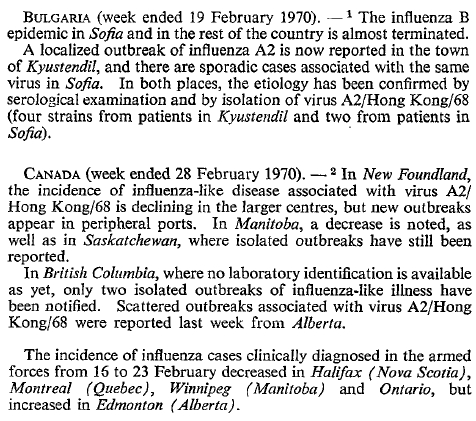
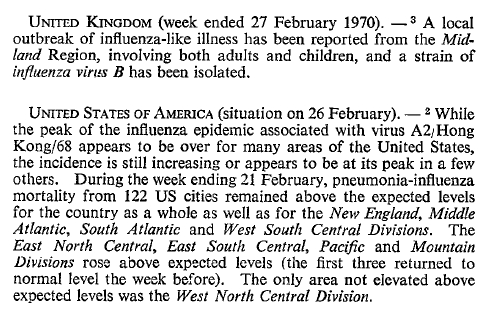
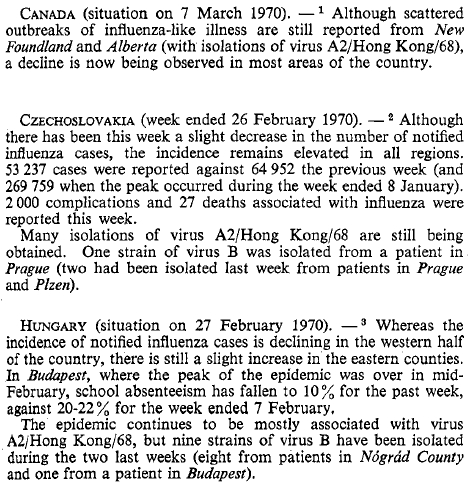


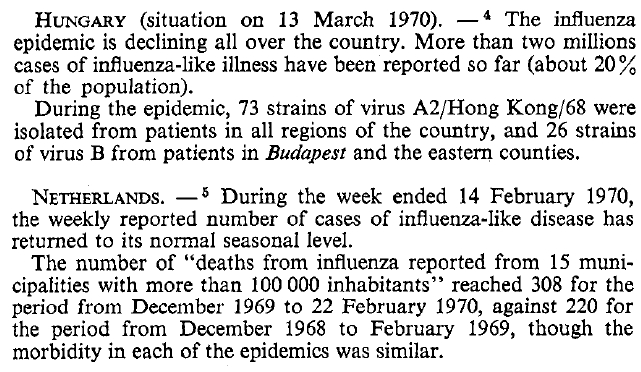
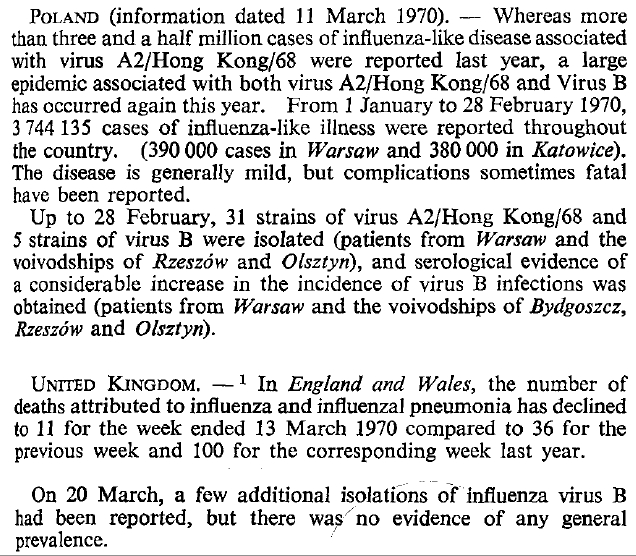
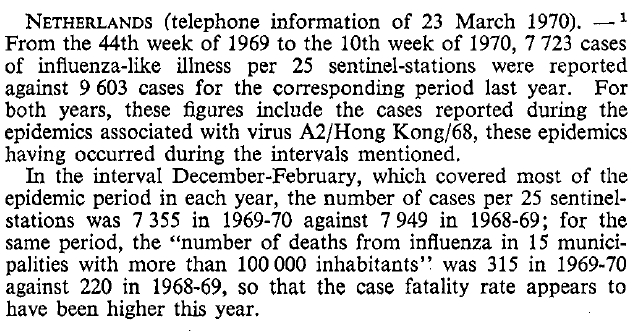

0 comments:
Post a Comment